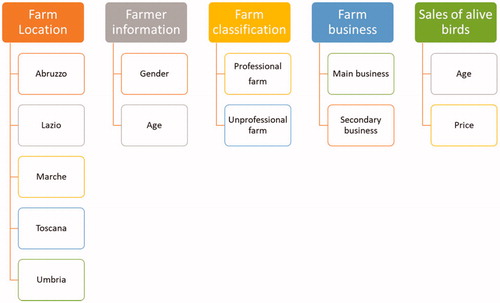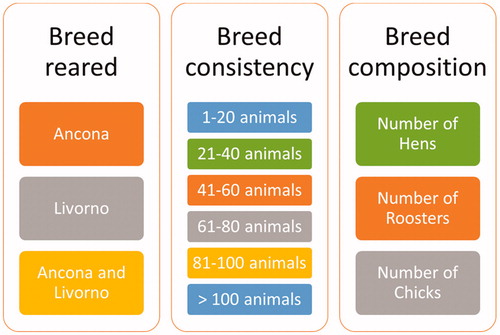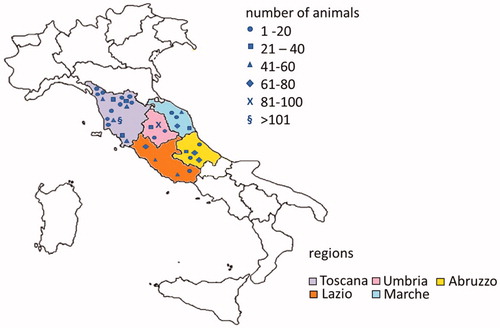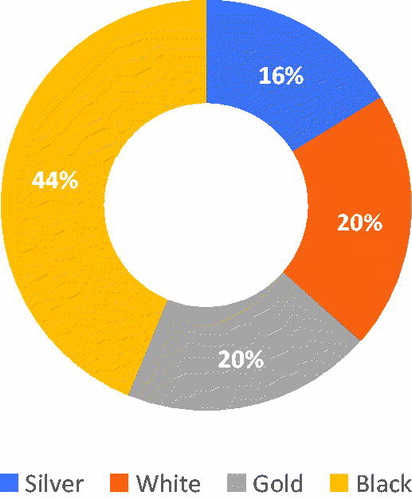Abstract
Nowadays most of the Italian chickens’ breeds are replaced with commercial hybrids characterised by higher productive performance. However, the safeguard of biodiversity and consequently the genetic variability are a very important issue, and for this reason, it is fundamental to include local strains in preservation programs. In Italy, the poultry Genealogic Book has been recently constituted, and includes 22 chicken breeds. The diffusion of these strains is strictly linked to the territory of origin, in particular in the Central Italy, the Ancona and Livorno chicken breeds are the mainly widespread ones. The aim of this study was to determine the consistency and the characteristics of the farms involved in the farming of Ancona and Livorno chicken breeds in Central Italy. A survey to analyse the facilities, the human resources and the chicken population consistencies was conducted in the farms of Abruzzo, Lazio, Marche, Tuscany and Umbria regions. All the investigated farms can be identified as ‘hobby-farms’ being small scale ones and leading the breeding of Ancona and Livorno chickens as a secondary business. The survey also confirmed that the presence of the strains depends on the region: 100% of Marche farms bred Ancona whereas, in Tuscany the Livorno breed is the most common.
A survey in centre Italy was carried out to determine the consistency of Ancona and Livorno chicken breeds;
The Ancona and Livorno chickens breed were reared in small scale farms;
The widespread of the breeds depend on the region: Ancona breed is most present in the Marche region while the Livorno is mainly bred in Tuscany.
Highlights
Introduction
Nowadays, most poultry production comes from intensive farming systems, which use high-performing animals whereas those obtained by the organic and free-range systems are present only as niche products (Meluzzi and Sirri Citation2009).
These high-performing chickens are reared in houses with controlled environmental conditions (temperature, humidity, light etc.) and subjected to specific protocols in order to allow high performance. This state has a negative impact on the local chicken strains because they were almost entirely substituted with high performing genotypes.
However, the strong selection for productive traits led to the loss of genetic variability (Tixier-Boichard Citation2020) and a consequent lower response of animals to climatic change and diseases. Poultry biodiversity is seriously threatened (Wimmers et al. Citation2000), and its safeguard is a clear objective in developed and undeveloped countries (Sirri et al. Citation2018; Soglia et al. Citation2020).
In particular, high performing chicken had low adaptation capability render them not suitable for organic and free-range systems (Dal Bosco et al. Citation2010; Castellini et al. Citation2016; Cartoni Mancinelli et al. Citation2020) due to welfare problems like leg disorders, cardiovascular diseases and high mortality rates (Hartcher and Lum Citation2020). This situation is particularly true for meat-type birds while egg-type layers show certain adaptability to rural farming systems.
On the contrary, local breeds show higher adaptability to local environmental conditions and diseases resistance (Abdelqader et al. Citation2008). Unfortunately, they are characterised by poor productive performance and their use in commercial production would be unprofitable.
Local chicken breeds are fundamental for the maintenance of genetic variability and the conservation of biodiversity is relevant for future improvement in animal science (Zanetti et al. Citation2010).
In 2014, the Italian Ministry of Agriculture and Forestry (MIPAAF Citation2014) established the register of Italian poultry breeds which was recently replaced by the Poultry Genealogical Book (MIPAAF 2019) that includes 22 local chicken breeds. This constitutes a useful tool for identifying breeders that comply with the breed standard and monitor the consistency of local poultry populations. Furthermore, the MIPAAF in 2017–2020 funded the first Italian project on poultry biodiversity preservation (CitationTuBAvI Project, https://www.pollitaliani.it/en/).
In Italy, the diffusion of local chicken breeds is connected to the territory. In particular, Ancona and Livorno are characteristic of Central Italy. Both breeds are egg-type breeds (Mugnai et al. Citation2009): the adult body weight ranges between 2.2 and 2.7 kg in the rooster and 1.8–2.4 in the hen.
The Ancona and Livorno differ in the colour of the plumage. Specifically, the Ancona is a black chicken with white-tipped feathers, whereas the Livorno has different plumage colorations as white, black, blue fawn, silver neck, gold neck, orange neck, barred and pile (AIA-Italian Breeder Association 1994Citationn.d.). Both breeds are commonly reared in small-scale farms in free-range systems and used for egg production (Mugnai et al. Citation2009; Di Rosa et al. Citation2020).
The purpose of this study is to analyze the distribution of Ancona and Livorno chickens in Central Italy. For this aim, a survey was conducted in several farms of Central Italy (Abruzzo, Lazio, Marche, Tuscany e Umbria regions) analysing the human resources, the farming structures and the birds’ consistence.
Materials and methods
Experimental design
The survey analysed the consistency and the characteristics of the farms involved in the conservation of Ancona and Livorno breeds that are typical of the Central Italy (Abruzzo, Lazio, Marche, Tuscany and Umbria). The survey was done in collaboration between the University of Perugia, Pisa and Firenze during March–August 2018.
The farms to be surveyed were identified by contacting:
National associations of farmers:
Italian breeder association (AIA),
Agri-food technology institution (3A-PTA);
private associations of Ancona e Livorno breeds:
Club Ancona breeders,
Livorno Breed Club;
National and regional associations of ornamental poultry breeds:
Italian Federation of Poultry (FIAV),
Umbrian poultry association (AUAv)
Abruzzo and Marche poultry association (S.A.M.A.S.A.).
Forty-one farms distributed in the five Italian regions (Table ) were identified. All the farms were contacted by phone and participants were over the age of 18. The second step consisted of an inspection of the selected farms consisting in:
Table 1. Number and distribution of the survey farms in the five regions of the Central Italy.
verify that chickens were conformed to the breed standard (AIA breeds standard);
compilation of the survey:
General information (Figure ) to better understand: the position of the farm, data relating to the farmer (gender and age), the productive trend of the farm (professional or non-professional farm) and the type of the business carried out (main or secondary business) including also the possibility of selling live animals.
Specific farm information (Figure ) to define the consistency of the breeds (number of animals) and the classification of birds (hens, cocks and chicks).
Moreover, because the breed standard of Livorno allows different plumage colours, it was also classified in: silver, white, gold and black.
Statistic procedure
Data were entered in Microsoft office excel (2007) using manual double entry and checked for data entry errors. The analysis software JMP 9.0.1 (2009) (SAS Institute Inc., 2009, Cary, NC) was used for all statistical analyses of the data. The Chi-squared test, followed by Fisher test, was used to determine any significant difference in the distribution of the considered items within the two different farms categories, professional and unprofessional, and also between them. Same procedure was used to evaluate differences in the regional distribution of the two chicken breeds and of their population consistencies and composition. P-values of less than 0.05 were considered significant.
Results and discussion
In the last 50 years in Italy, the consistency of native chicken breeds has shown a dramatic decline, rapidly replaced by high performing animals.
Zanon and Sabbioni (Citation2001) reported that about 61.0% of Italian's chicken breeds are extinct and the 13.3% are endangered, while only the 6.7% are involved in conservation programmes.
The aim of this study was to provide information on the consistency and on the characteristics of the farms in central Italy where native chickens breeds (Ancona and Livorno) are still reared.
In the first step of the investigation (phone interview), three farms from Abruzzo region were eliminated as they interrupted the activity. Therefore, a total of 38 farms were suitable for the survey. Following the animal inspection, two other farms from Lazio region were excluded because the hens belonged to an industrial genotype, which presented morphological similarities to the autochthonous Livorno breed.
Thus, the farms suitable to be registered were 36 distributed as follows: 5 in Abruzzo, 4 in Lazio, 5 in Marche, 18 in Tuscany and 4 in Umbria.
There is a wide variability in the consistency of the animals reared in the farms (Figure ). The Tuscany region had half of the farms (n = 18) and the biggest farm (>100 chickens), the second farm in term of size is positioned in Umbria (animal between 81 and 100). However, most of the farms surveyed are small-scale farms. Our results showed that 17 farms have consistency between 1 and 20 animals, 6 farms have consistency between 21 and 40 animals, 7 farms have consistency between 41 and 60 animals, 4 farms have consistency between 61 and 80 animals, 1 farm have consistency between 81 and 100 animals and 1 farm >100 chickens. Most of the farm was unprofessional (71.4%), whereas only 28.6% were professional ones (Table ). About all the farms (91.7%) are managed by men with age comprises between 50 and 70 years for the professional and between 30 and 50 years for the unprofessional farms. All women belonged to the non-professional farms (only 8.3% of the farms) and the age was between 30 and 50 years.
Table 2. General information on the farms.
Despite 28.6% of surveyed farms were professional farms, only for 5.6% of them the poultry farming was the main business activity; conversely, the unprofessional farms considerate this activity as a secondary one.
Selling live chickens was recorded in the 33.3% of the farms. In those cases, no preferences were observed on the age of animals at sale, but in the 66.7% of the examined cases animals aged less than 6 months. The mean selling price was between 20 and 30 euro/bird (75.0%, p < 0.05).
The diffusion of the Ancona and Livorno was very different among the five regions of central Italy (Table ). In particular, there were a low number of farms that reared both breeds. All the farms surveyed in the Marche region reared only the Ancona chickens and this breed was most common in Abruzzo and in Lazio, with the 40% and 75% of farms, respectively. In Tuscany, the 77.8% and in Umbria the 50% of the farms had Livorno chickens.
Table 3. Consistencies of the Ancona and Livorno breeds in the five regions of Central Italy (Abruzzo, Lazio, Marche, Tuscany e Umbria).
A total number of 1.127 birds were recorded during the survey and the majority of them belongs to the Livorno breed (62.0%, p < 0.01) (Table ). The region with the highest number of animals was the Tuscany (p < 0.01), which represented 47.6% of the all surveyed animals. Abruzzo and Umbria were the regions with the lowest consistencies (9.9 and 20.8%, respectively).
Marche had the largest number of Ancona (n = 158) followed by Lazio (n = 152).
Both breeds showed differences in their composition (Table ): the Ancona seems to have a younger population, with 120 chicks compared to the 49 of Livorno. In both populations, the number of females was higher respect to the males but the male:female ratio is higher in Livorno respect to the Ancona (1:3 vs 1:5).
The Livorno was also classified according to the plumage colours (Figure ). The most common plumage was the black (44%) colour followed by the white and the gold, where the percentage was 20% for both. The silver plumage was less present.
Table 4. Composition of the populations of the Ancona and Livorno breeds in Central Italy.
The survey performed in Abruzzo, Lazio, Marche Tuscany and Umbria regions showed that most of the farms involved were small-scale farms in fact, one farm only reared more than 100 chickens. This small size is in accordance with the fact that 71.4% of farms were unprofessional and that among the professional farmers only 5.6% consider the chickens as the main business.
As previously reported, in most of the examined farms, chicken activity is a secondary business. This practice is increasingly widespread in the agricultural sector, so many Authors have defined it ‘hobby-farming’ (Gasson Citation1988; Cloke et al. Citation1998; Halfacree and Boyle Citation1998). The ‘hobby-farm’ represents a heterogenous group in terms of holdings, locations and activities (Holloway Citation2000). However, most of the income of the ‘hobby-farmers’ derive from sources other than farming so that most of the farmers selected animals on the base of their morphological characteristics often neglecting the productive aspects.
The range of age between professional and unprofessional farmers was different being between 50 and 70 years for professional farmers and between 30 and 50 years for the unprofessional ones. These results were consistent with those obtained by the Agricultural Census (2000). In particular, Piemonte (a region of the North of Italy) showed that the average age of the professional operators was 58 years, 35% were older than 65 years, and only 14% were 40 years old or younger (Corsi Citation2009).
As reported in our results, the sold of live animals was widespread among the farms and this behaviour contributes to render the connection breed-region very strong. Accordingly, the survey showed that all the farms in the Marche breed Ancona chickens. The same situation is in Tuscany for the Livorno breed where the breeders prefer the Livorno respect to the Ancona.
However, in central Italy, the most diffused breed was Livorno compared to Ancona (Ceccobelli et al. Citation2015).
The survey evidences a different composition between the population of Ancona and Livorno. In particular, the Ancona breed was characterised by a higher number of chicks and lower number of hens with respect to the Livorno breed with a male:female ratio higher as compared to the Livorno. Probably, Ancona breed is used mainly for producing hens and cocks for reproduction purpose while, the Livorno is used for egg production and self-consumption purposes.
As regard Livorno, the farmers raise different plumage liveries; those detected (black, gold, silver and white) are all recognised by breed standards (AIA-Italian breeder association). This confirms the amateur direction of the farms, since the reared of the animals was mainly based on the morphological characteristics of the birds, the farmers prefer raised a low number of chickens but characterised by different plumage liveries.
Conclusions
In central Italy, the Ancona and Livorno chickens were reared in small scale farms, most of them can be identified as ‘hobby-farm’.
The number of animals per farm was very low and only one farm exceeded 100 chickens.
Most of the surveyed farms bred the Ancona and Livorno as secondary business and sell life animals. The diffusion of the two breeds is strictly connected to the region. Indeed, in the Marche region all the farms bred the Ancona chickens whereas in Tuscany the Livorno breed was more common.
It would be appropriate to include these breeds in the conservation programs by stimulating the breeders to participate at the Genealogical Book also through economic incentives to make the farming of these breeds more competitive.
In order to promote this kind of breeding, it would be important to develop a common brand name that helps to identify the products coming from native Italian breeds.
Furthermore, a useful tool to improve the information inside of the same farm (i.e. to control degree of consanguinity) could be the use of an interactive ‘cip’ applied on the leg of the animal through a ring. By a reader, it will be possible to receive information on the animal such as: age, sex, genealogy, performance, etc.
Disclosure statement
No potential conflict of interest was reported by the author(s).
Additional information
Funding
References
- AIA-Italian breeder association n.d. Breed standards www.aia.it.
- Abdelqader A, Wollny CBA, Gauly M. 2008. On-farm investigation of local chicken biodiversity and performance potentials in rural areas of Jordan. Anim Genet Resour Inf. 43:49–57.
- Cartoni Mancinelli A, Mattioli S, Dal Bosco A, Aliberti A, Guarino Amato M, Castellini C. 2020. Performance, behavior, and welfare status of six different organically reared poultry genotypes. Animals. 10(4):550.
- Castellini C, Mugnai C, Moscati L, Mattioli S, Guarino Amato M, Cartoni Mancinelli A, Dal Bosco A. 2016. Adaptation to organic rearing system of eight different chicken genotypes: behaviour, welfare and performance. Ital J Anim Sci. 15(1):37–46.
- Ceccobelli S, Di Lorenzo P, Lancioni H, Monteagudo Ibáñez LV, Tejedor MT, Castellini C, Landi V, Martínez Martínez A, Delgado Bermejo JV, Vega Pla JL, et al. 2015. Genetic diversity and phylogeographic structure of sixteen Mediterranean chicken breeds assessed with microsatellites and mitochondrial DNA. Livestock Science. 175:27–36.
- Cloke P, Phillips M, Thrift N. 1998. Class, colonisation and lifestyle strategies in Gower. In: Boyle P, Halfacree K, editors. Migration into rural areas. Chichester: Wiley. p. 166–185.
- Corsi A. 2009. Family farm succession and specific knowledge in Italy. Rivista di Economia Agraria. 64(1-2):13–30.
- Dal Bosco A, Mugnai C, Sirri F, Zamparini C, Castellini C. 2010. Assessment of a global positioning system to evaluate activities of organic chickens at pasture. J Appl Poult Res. 19(3):213–218.
- Di Rosa AR, Chiofalo B, Lo Presti V, Chiofalo V, Liotta L. 2020. Egg quality from Siciliana and Livorno Italian autochthonous chicken breeds reared in organic system. Animals. 10(5):864.
- Gasson R.M. 1988. The economics of part-time farming. Longman, Harlow.
- Halfacree K, Boyle P. 1998. Migration, rurality and the post-productivist countryside. Wiley, Chichester , pp 1–20.
- Hartcher KM, Lum HK. 2020. Genetic selection of broilers and welfare consequences: a review. World's. Poultry Sci J. 76(1):154–167.
- Holloway L. 2000. Hell on earth and paradise all at the same time’: the production of smallholding space in the British countryside. Area. 32(3):307–315.
- Meluzzi A, Sirri F. 2009. Welfare of broiler chickens. Ital J Anim Sci. 8(sup1):161–173.
- Ministero delle Politiche Agricole, Alimentari e Forestali (MIPAAF). 2014. Disciplinare del Registro anagrafico degli avicoli autoctoni. Decreto Ministeriale n. 19536 of October 1st, 2014.
- Ministero delle Politiche Agricole, Alimentari e Forestali (MIPAAF). 2019. Disciplinare del Libro Genealogico degli avicoli autoctoni. Decreto Ministeriale n. N. 38992 of December 5th, 2019.
- Mugnai C, Dal Bosco A, Castellini C. 2009. Effect of farming system and season on the performance and egg characteristics of Ancona laying hens. Ital J Anim Sci. 8(2):175–188.
- Sirri F, Zampiga M, Soglia F, Meluzzi A, Cavani C, Petracci M. 2018. Quality characterization of eggs from Romagnola hens, an Italian local breed. Poultr Sci. 97(11):4131–4136.
- Soglia D, Sartore S, Maione S, Schiavone A, Dabbou S, Nery J, Zaniboni L, Marelli S, Sacchi P, Rasero R. 2020. Growth performance analysis of two Italian slow-growing chicken breeds: Bianca di Saluzzo and Bionda Piemontese. Animals. 10(6):969.
- Tixier-Boichard M. 2020. From the jungle fowl to highly performing chickens: are we reaching limits? World's Poult Sci J. 76:2–17.
- TuBAvI Project. Italy [accessed 2020 March 10]. www.pollitaliani.it/en/
- Wimmers K, Ponsuksili S, Hardge T, Valle‐Zarate A, Mathur PK, Horst P. 2000. Genetic distinctness of African, Asian and South American local chickens. Anim Genet. 31(3):159–165.
- Zanetti E, De Marchi M, Dalvit C, Cassandro M. 2010. Genetic characterization of local Italian breeds of chickens undergoing in situ conservation. Poult Sci. 89(3):420–427.
- Zanon A, Sabbioni A. 2001. Identification and genetic protection of Italian poultry breeds. Annali della Facolta di Medicina Veterinaria-Universita di Parma (Italy).




